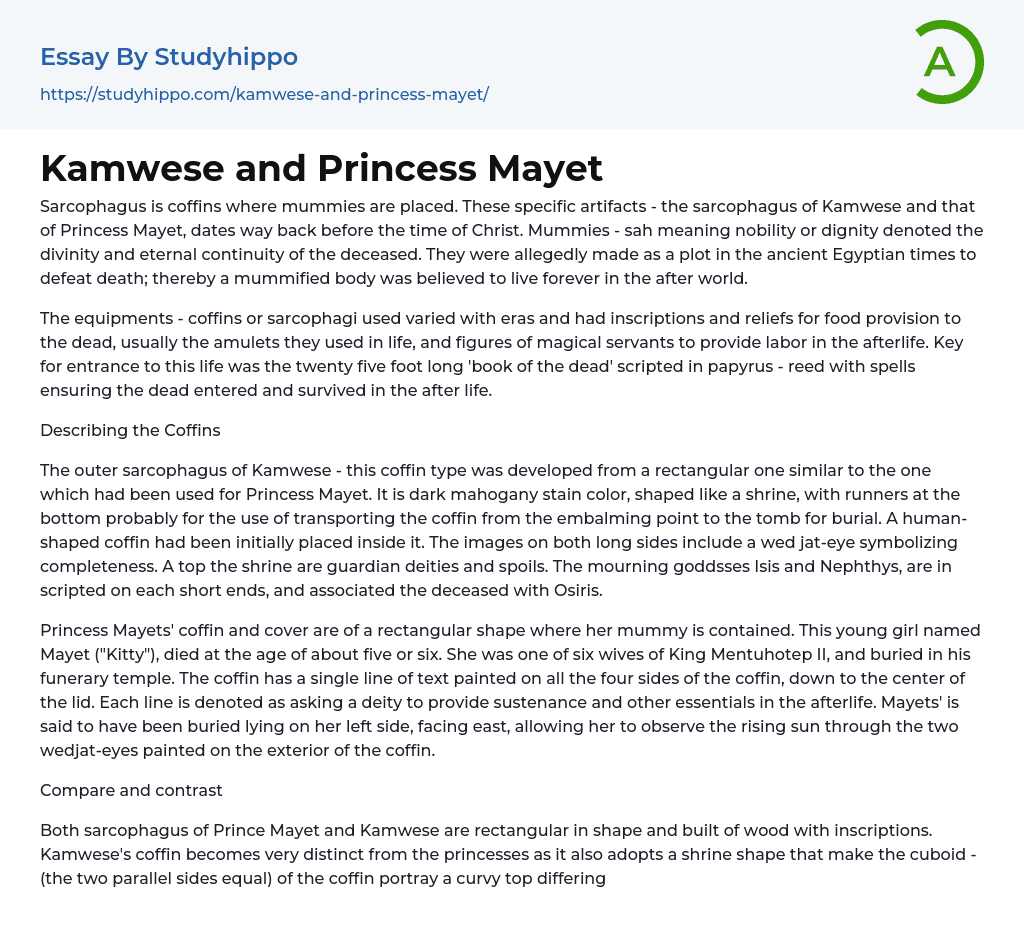Sarcophagus is coffins where mummies are placed. These specific artifacts - the sarcophagus of Kamwese and that of Princess Mayet, dates way back before the time of Christ. Mummies - sah meaning nobility or dignity denoted the divinity and eternal continuity of the deceased. They were allegedly made as a plot in the ancient Egyptian times to defeat death; thereby a mummified body was believed to live forever in the after world.
The equipments - coffins or sarcophagi used varied with eras and had inscriptions and reliefs for food provision to the dead, usually the amulets they used in life, and figures of magical servants to provide labor in the afterlife. Key for entrance to this life was the twenty five foot long 'book of the dead' scripted in papyrus - reed with spells ensuring the dead entered and survived
...in the after life.
Describing the Coffins
The outer sarcophagus of Kamwese - this coffin type was developed from a rectangular one similar to the one which had been used for Princess Mayet. It is dark mahogany stain color, shaped like a shrine, with runners at the bottom probably for the use of transporting the coffin from the embalming point to the tomb for burial. A human-shaped coffin had been initially placed inside it. The images on both long sides include a wed jat-eye symbolizing completeness. A top the shrine are guardian deities and spoils. The mourning goddsses Isis and Nephthys, are in scripted on each short ends, and associated the deceased with Osiris.
Princess Mayets' coffin and cover are of a rectangular shape where her mummy is contained. This young girl named Mayet ("Kitty"), died at the
age of about five or six. She was one of six wives of King Mentuhotep II, and buried in his funerary temple. The coffin has a single line of text painted on all the four sides of the coffin, down to the center of the lid. Each line is denoted as asking a deity to provide sustenance and other essentials in the afterlife. Mayets' is said to have been buried lying on her left side, facing east, allowing her to observe the rising sun through the two wedjat-eyes painted on the exterior of the coffin.
Compare and contrast
Both sarcophagus of Prince Mayet and Kamwese are rectangular in shape and built of wood with inscriptions. Kamwese's coffin becomes very distinct from the princesses as it also adopts a shrine shape that make the cuboid - (the two parallel sides equal) of the coffin portray a curvy top differing from the top cover of the princess's coffin which remains a flat lid. Some inscriptions in the coffins are similar but denote different meanings. Though they all have the wedjat - eye painted in them, the positions are different i.e. Mayets' is on the eastern side off the coffin to facilitate viewing of the rising sun, while Kamweses' has the wedjat-eye on both sides of the coffin symbolic to completeness.
There are lines and runners in both, but while in Mayets' each line denotes begging divine to provide sustenance and other life essentials as a princess - (note this would be different for Kamwese an ordinary man) and a royal. Each additional line is a renewed request and an increased asking guaranteeing provision. Kamweses's runners are purposive for transporting the
body. Mayets' coffin is narrower, attribution of design and probably the difference in eras, Kamwese's being more recent and developed from Mayet's design. It could be therefore a product of improvement and in style with Kawese's time of death - era.
Though Kamwese's coffin was developed from Mayet's (a royal) design, it looks more elegant than the princess's, probable due to improved design and difference in time, one from middle kingdom and the other a new kingdom. This is a contrast as in the ancient Egypt; the royals lived better and buried their dead with more nobility than ordinary men. It was therefore expected that the sarcophagi of Mayet be more elegant than that of Kamwese. Again his could be the attribution of the difference in eras, thus different in style and values. Mayet's sarcophagus is distinct from those normally found in royal tombs of ancient Egypt.
- Rabbit essays
- Distribution essays
- Large Animals essays
- Mouse essays
- Poultry essays
- Animal Abuse essays
- Cats Vs Dogs essays
- Cattle essays
- Territory essays
- Ranch essays
- Culture essays
- Social Control essays
- Citizenship essays
- Social Justice essays
- Caste System essays
- Social Responsibility essays
- Socialization essays
- Deviance essays
- Modern Society essays
- Popularity essays
- Civil Society essays
- Community essays
- Female essays
- Filipino People essays
- Igbo People essays
- Indigenous Australians essays
- Indigenous Peoples essays
- Minority Group essays
- Social Institution essays
- Men essays
- The nation essays
- Middle Class essays
- Social Norms essays
- Discourse Community essays
- Popular Culture essays
- Car Culture essays
- American Culture essays
- Mormon essays
- Indian Culture essays
- Mexican Culture essays
- Pop Culture essays
- Cultural Differences essays
- Culture Shock essays
- Different Cultures essays
- Abolitionism essays
- Adam Smith essays
- American History essays
- American Revolution essays
- Ancient Egypt essays
- Articles Of Confederation essays




